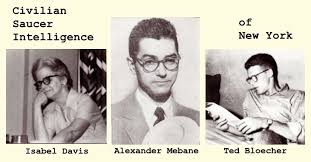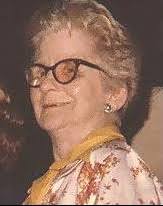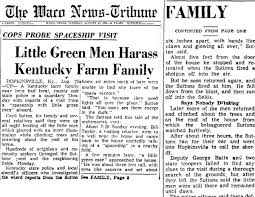By Charles Lear

In 1955, UFO investigation methods that could provide data appropriate for scientific scrutiny were still being developed and refined. The U.S. Air Force investigators for Project Blue Book had made major progress in terms of gathering data and organizing it thanks to the efforts of Captain Edward J. Ruppelt during his oversight in 1952 and investigators from private organizations would later have a model they could follow thanks to Donald Keyhoe and his group, the National Investigations Committee on Aerial Phenomena, formed in 1956. The Air Force and N.I.C.A.P. focused on witness accounts backed up by photos, films, trace evidence and radar confirmations of tangible objects in an attempt to prove or disprove the extraterrestrial hypothesis. Because the Kelly-Hopkinsville case (described in part 1 of this blog) only had witness testimony of a very bizarre nature, neither organization saw fit to undertake a detailed investigation.
There were, at least, three serving members of the Air Force, from nearby Fort Campbell, who visited the Kelly farm in an unofficial capacity. One of them, Major John E. Albert, issued a report to Project Blue Book, more than two years after the events, in response to a written request from CWO William T. Thomas USAF at Air Technical Intelligence Center. The request is dated August 29, 1957 and, in paragraph 2, Thomas expressed concern that there was a magazine article about the case soon to be published and that the Air Force would be asked to comment. Thomas emphasized, in paragraph 3, that “no credence can be given this almost fantastic report” and that it was never officially reported to the Air Force. N.I.C.A.P. received a report from Albert Andre of Green Briar, Tennessee, but it was based on an interview with Glennie Lankford that he conducted in 1959. If future researchers only had the above sources to reference, many details of the case might have never come to light. Fortunately, a local man with an interest in the Kelly happenings, took it upon himself to interview the witnesses with an inspired approach on August 22, 1955, the morning after their reported encounter.
Andrew “Bud” Ledwith was an engineer and announcer for the local radio station WHOP. He had been at home working on his hobby, amateur radio, when he encountered a technical problem that prompted him to drive to the station in order to consult with one of his fellow engineers. At the station, he was informed of the events at the Kelly farm the night before. Ledwith had recently read a magazine article about police sketch artists working with witness descriptions to reconstruct the facial features of suspects. Having studied art himself, he thought that this would be a means to “clarify the situation.” Ledwith drove to the farm, bringing with him the station owner’s son, Mike Lackey, to insure that he didn’t lead or influence the witnesses.
Ledwith arrived at an opportune moment. The men from the house were all away and the crowds of curiosity seekers had yet to arrive. Glennie Lankford was sitting in a rocking chair in the front yard and Ledwith introduced himself and Lackey. He asked if she and the other three women, Vera Sutton, Alene Sutton and June Taylor, would be willing to give him an account of the former night’s events and describe the creatures they’d seen while he sketched. Lankford invited them into the living room and, with the agreement of all, they began. Ledwith described the process in a written report and emphasized that he was immediately corrected whenever he made any sort of suggestion about a particular feature. He wrote that when the sketch was completed to everyone’s satisfaction, the image disturbed Mrs. Lankford to where she no longer wanted to look at it.
Around noon, Ledwith walked out to the field in back of the house and came upon two state troopers. He discussed the case with them and asked if the state police would be interested in having a copy of his sketch. They answered positively and it, along with copies of two other sketches, was picked up a week later from the radio station. Later in the day, he offered a copy to an Air Force officer, who expressed no interest in it. At 12:30 p.m., a taped interview with Mrs. Lankford was scheduled to be broadcast on WHOP and because there was no radio in the house, Ledwith invited Mrs. Lankford to listen to it on his car radio. Ledwith and Lackey then went to the gully on the neighboring property where the “spaceship” was reported to have landed. They “searched it thoroughly” and found no indication that anything unusual had been there.
At 1:45 p.pm., Billy Ray Taylor returned from his hunting trip, walked into the house and saw the sketch. He shouted, “That’s it, that’s it, that looks just like it!” and Ledwith described getting “cold chills.” Ledwith asked Taylor if they could make a sketch from his description and they went to the bedroom to do so. The resulting depiction was quite similar to the one done with the women. Ledwith and Lackey returned to Hopkinsville after asking permission to visit the farm later that evening when the other men would be back from Evansville, Ohio.
Ledwith was back at the farm at 7:30 p.m. and the men returned an hour later. By this time, the crowds had arrived and the men were forced to park far from the house. The men, Elmer “Lucky” Sutton, his brother, J.C. Sutton and J.C.’s brother-in- law, O.C. Baker, came into the house after talking with Lankford, the mother of the Suttons. Ledwith described Lucky as having entered the house like a “bear.”
Ledwith wrote that he felt Lucky was prepared to throw him out of the house but that he stopped short when he saw the women’s drawing on a table. Ledwith described him sitting down and immediately making the correction that the face was round and that the chin did not come to a point. Ledwith then made another sketch with the three men and got an account of the night’s events from them as well.
 Ledwith’s report was made available in (warning: memory hog), “Close Encounters at Kelly and Others of 1955” published in 1978 by the Center for UFO Studies founded by Project Blue Book consultant, J. Allen Hynek. The authors, Isabel Davis and Ted Bloecher, were members of Civilian Saucer Intelligence of New York and had had a long relationship with Hynek, supplying him with many reports during his days with Blue Book. In a report to CSI members for the summer and fall of 1955, it is mentioned that the “story of ‘luminous little green men’ seen in Hopkinsville, Kentucky… is believed to be probably true.” In June of 1956, Isabel Davis, a highly respected researcher and treasurer for CSI, made the trip to Hopkinsville to look into the story.
Ledwith’s report was made available in (warning: memory hog), “Close Encounters at Kelly and Others of 1955” published in 1978 by the Center for UFO Studies founded by Project Blue Book consultant, J. Allen Hynek. The authors, Isabel Davis and Ted Bloecher, were members of Civilian Saucer Intelligence of New York and had had a long relationship with Hynek, supplying him with many reports during his days with Blue Book. In a report to CSI members for the summer and fall of 1955, it is mentioned that the “story of ‘luminous little green men’ seen in Hopkinsville, Kentucky… is believed to be probably true.” In June of 1956, Isabel Davis, a highly respected researcher and treasurer for CSI, made the trip to Hopkinsville to look into the story.
The first person Davis spoke to was the Hopkinsville Chief of Police, Russell Greenwell. Greenwell had had a UFO sighting of his own in 1952 and Davis felt that his lack of skepticism made him a useful source of information. She discovered that Glennie Lankford had sold the farm to her nephew and was, at that point in time, living in Hopkinsville. She also learned that the family had become embittered and reclusive due to ridicule from the public and the press and were refusing to further discuss the case. Fearing outright rejection, Davis went to the house in Hopkinsville without calling first and met Mrs. Lankford, who remained behind her screen door while Davis pleaded with her for an interview. Lankford finally agreed with the stipulation that she would only discuss what she’d seen with her own eyes. For Davis, the interview was worth her long trip because it provided her with first-hand insight into Lankford’s character and a statement about seeing a creature come up to a window as she was trying to sleep: “I turned my head three different times, because I thought maybe my eyes were fooling me. But every time I turned my head back, there he was.”
 Davis talked to state and local police officers, the Christian County Sherriff, and local reporters who were on the scene. Most importantly, she spoke with Ledwith and was able to compare her information with his. Ledwith would later provide her with copies of the drawings, witness statements and affidavits when she wrote her report for the CUFOS publication. “Close Encounter at Kelly” is a thorough account that includes lists of primary witnesses and sources of information, maps of the area and Kelly farm, plan view layout of the farm house, Ledwith’s report and drawings, photos from local news agencies and documents from the Project Blue Book File. It remains as the most detailed and comprehensive source for students of the case. Though the case won’t stand up to science, it is still compelling thanks to some good investigatory methods employed by both Ledwith and Davis. Davis should have better separated his witnesses but getting statements and affidavits from them in addition to the drawings was, in this writer’s opinion, pretty good for a first-timer.
Davis talked to state and local police officers, the Christian County Sherriff, and local reporters who were on the scene. Most importantly, she spoke with Ledwith and was able to compare her information with his. Ledwith would later provide her with copies of the drawings, witness statements and affidavits when she wrote her report for the CUFOS publication. “Close Encounter at Kelly” is a thorough account that includes lists of primary witnesses and sources of information, maps of the area and Kelly farm, plan view layout of the farm house, Ledwith’s report and drawings, photos from local news agencies and documents from the Project Blue Book File. It remains as the most detailed and comprehensive source for students of the case. Though the case won’t stand up to science, it is still compelling thanks to some good investigatory methods employed by both Ledwith and Davis. Davis should have better separated his witnesses but getting statements and affidavits from them in addition to the drawings was, in this writer’s opinion, pretty good for a first-timer.
- Allen Hynek was made aware of the case a “few months after it had occurred.” He wrote about it in his 1972 book, “The UFO Experience: A Scientific Inquiry.”
In the book, Hynek wrote that he was in the process of “setting up 12 satellite tracking stations around the world” when he was told about the case by an employee of his. In an amazing happenstance, that employee was none other than Andrew “Bud” Ledwith.